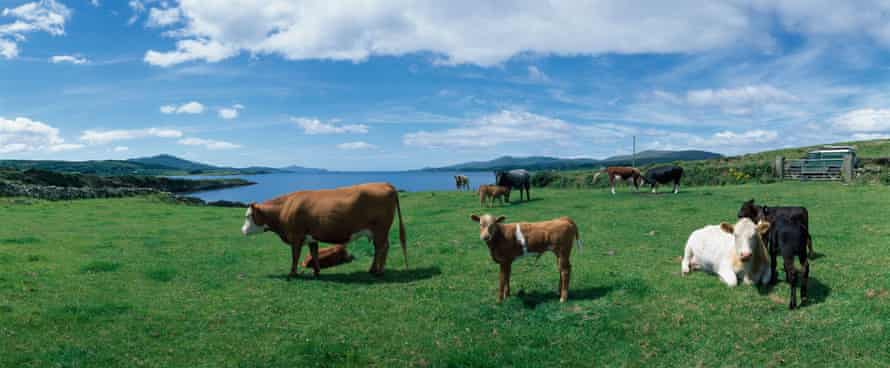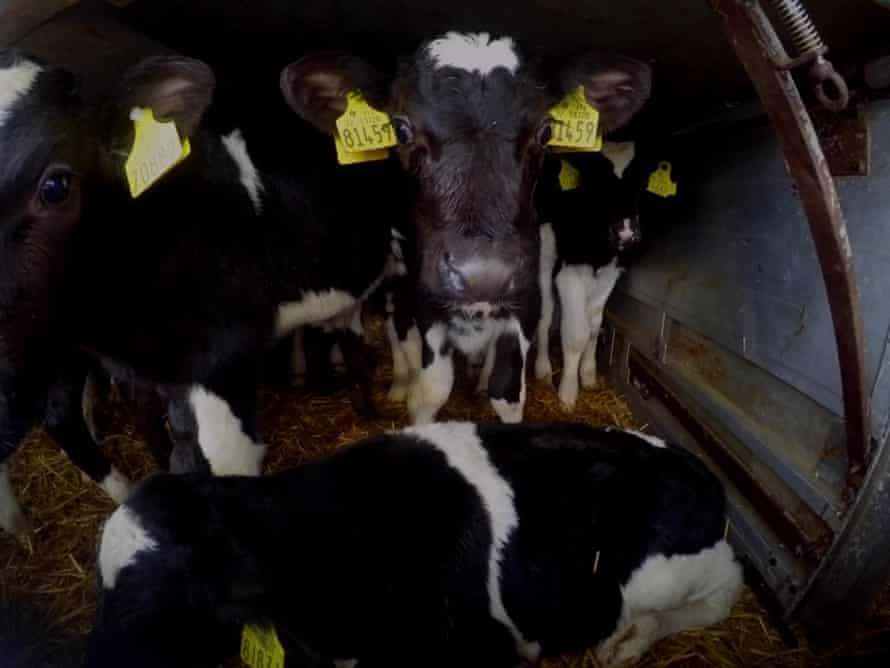Irish authorities have announced plans to fly unweaned dairy calves from Ireland to other EU destinations from May, in an effort to address growing unease about the length of the journeys made by thousands of animals shipped each year to mainland Europe.
The Irish government has been subject to sustained scrutiny over live calf exports and the decision to experiment with flights, which will significantly cut travel time, comes as a European parliament committee of inquiry examines alleged failures across Europe in enforcing rules on protecting transported animals.
Ireland’s 1.6 million dairy herd is ever-expanding and the country is grappling with increasing numbers of calves born each spring. About 750,000 male dairy calves are born each year. Most are sold into the domestic beef sector, but approximately 30,000 are slaughtered, while 200,000 are earmarked for live export by road and sea for veal production on the continent.
It is the fate of these 200,000 calves – some transported at 14 days of age – that is of increasing concern to Irish authorities, amid continued criticism from animal welfare campaigners who claim the rules governing calf transport are routinely flouted. They say Irish calves have experienced “nightmare journeys” without access to water or food.
The Dutch government has continued to push for an EU-wide ban on journeys over eight hours for all unweaned animals. The Guardian has learned that the Dutch agriculture minister has communicated to the country’s veal calf industry that it should “sharply reduce and eventually stop” all imports of calves from faraway farms. The Netherlands is a key export market for Ireland’s unweaned calves.

Farming groups have welcomed the air trial. “We want to see calves flying out of this country,” the president of the Irish Farmers’ Association, Tim Cullinan, told the Irish parliament in December. He said while the cost of flying is double that of sea transport, flights would also enable the industry to reach new markets. But some campaigners strongly oppose the idea.
“Flying calves sounds horrific,” said Caroline Rowley of Ethical Farming Ireland, a nonprofit organisation she founded in 2019. “I don’t understand the logistics. It’s still going to be a long journey of turning up to the airport, unloading calves from trucks into pens. It’s noisy in the plane – there’s air pressure changes and turbulence. Flying them is avoiding the fundamental issue: we are producing too many animals.”
Ireland fearful of EU ban on calf exports
The search for new markets cited by farmers – inside and outside Europe – is now more urgent because the Dutch agriculture minister, Carola Schouten, is putting pressure on the veal industry to stop buying calves that have undergone long journeys.
“We have concerns regarding the welfare of these vulnerable animals during these long journeys,” said her spokesperson, Raoel Koole. “The veal calf industry in the Netherlands should not be dependent on these imports.”
Teagasc, Ireland’s state agency for agri-food research, is leading the project to fly calves out of the country and it is thought the first plane-load will leave in May. The publicly-funded EUR1.2m (GBP1m) project, called “Moove”, will include an assessment of calf welfare as the animals are transported on planes and ferries, and it will also examine the potential of slow-release nutrition that can mimic feeding over a long period.
The Irish government’s 2010 expansion plan encouraged farmers to grow and intensify their dairy enterprises. While the average price paid to farmers for milk is near the bottom of the international league and has not changed much in relative terms for more than two decades, many parts of the dairy industry have boomed in the past decade and herd size and milk output have shot up.
But the authorities have faced criticism for an apparent lack of oversight regarding calf welfare, and the Moove project is seen as a way to rebalance the paucity of data.

“We want to put a baseline on the welfare, compared to welfare of calves that wouldn’t be travelling,” said Pat Dillon, who leads Teagasc’s animal research centre in Fermoy, County Cork, and is overseeing the five-year project.
EU law states that calves should not travel longer than eight hours and while this suits mainland Europe’s veal industry, travel from Ireland takes much longer.
An exemption was written into EU legislation in 2005. Calves exported from Ireland must rest for 12 hours after unloading at the port of destination – in Ireland’s case usually Cherbourg, France. This still leaves the problem of feeding them along the way, and welfare groups argue that because the journey is so long, calves go without sufficient feed for lengthy periods, contravening the law.
Calves ‘flooding’ the market in spring
The Teagasc dairy model further complicates the problem. The compact spring calving system means a glut of calves are born within a six to eight-week period from February to April. Farmers are advised to practise so-called “snatch calving”, where offspring are removed from their mothers within an hour of birth. They are also told to sell the bull calves “as soon as possible“. This sudden flush of thousands of calves can drive down prices; in 2019, bull calves reportedly sold for less than 50 cents (43p) each.
This has caused a headache for live exporters. “The six-week calving pattern is flooding the market,” said John Hallissey, secretary of the Irish Livestock Exporters Association. “There are too many calves coming at once – if that period was spread out, it would help the situation. Ideally, calves should be that bit older and stronger to take the journey – the best environment for the calf to grow is being fed new milk in the farm of origin for 21 days.”

Hallissey said it is in exporters’ best interests that calves arrive at their destination in good condition. “That’s what we get paid for,” he said. “Calves are travelling well by road and are being well looked after.”
Speaking to the European parliament’s committee of inquiry in February, Rob Doyle, a civil servant in Ireland’s agriculture department, admitted that while there are gaps in scientific knowledge in relation to live animal transportation, the argument about journey times should be about data rather than about distance.
“It is vital that this debate is based in objective evidence and scientific research, rather than conducted around subjective opinions on social media,” he said. “The banning of live export would have consequences that would require significant management back on the farms in Ireland.”
Sign up for the Animals farmed monthly update to get a roundup of the best farming and food stories across the world and keep up with our investigations. You can send us your stories and thoughts at animalsfarmed@theguardian.com